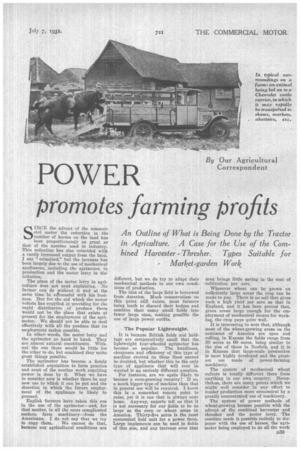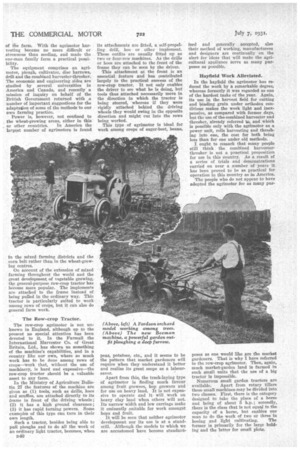POWER Correspondent promotes farming profits
Page 93

Page 94

If you've noticed an error in this article please click here to report it so we can fix it.
An Outline of What is Being Done by the Tractor in Agriculture. A Case for the Use of the Com bined Harvester Thresher. Types Suitable for Market-garden Work
SINCE the advent of the commercial motor the reduction in the number of horses on the land has been proportionately as great as that of the number used in industry. This reduction has also coincided with a vastly increased output from the land. I say "coincided," but the increase has been largely due to the use of mechanical appliances, including the agrimotor, in production and the motor lorry in distribution.
The place of the motor lorry in agriculture does not need explaining. No farmer can do without it and at the same time be strecessful with his business. But for the aid which the motor vehicle has supplied in providing for the rapid distribution . of produce there would not be the place that exists at • present for the employment of the agrimotor. We should not be able to deal effectively with all the produce that its employment makes possible.
In other words, the motor lorry and the agrimotor go hand in hand. They are almost natural constituents. Without the one there would be little for the other to do, but combined they make great things possible.
The agrimotor has become a firmly established acquisition to farm practice and most of the routine work requiring power is done by it. What we have to consider now is whether there be any new use to which it can be put and the direction in which the future employment of the appliance is likely to proceed.
English farmers have taken this cue in the use of the agrimotor----and, for that matter, in all the more complicated modern farm machinery—from the Americans. I do not say that wo try to copy them. We cannot do that, because our agricultural conditions are
different, but we do try to adapt their mechanical methods to our own conditions of production.
The idea of the large field is borrowed from America. Much conservatism on this point still exists, most farmers being loath to discard their hedges and combine their many small fields into fewer large ones, making possible the use of large power outfits.
The Popular Lightweight.
It is because British fields and holdings are comparatively small that the lightweight four-wheeled agrimotor has become so popular. The handiness, cheapness and efficiency of this type of machine evolved on these lines cannot be doubted, but whether this be the only type of appliance that will ever be wanted is an entirely different question.
For instance, are we again likely to become a corn-growing country? If so, a much bigger type of machine than that in general use will be required. I know this is a somewhat remote point to raise, yet it is one that is always near home. Anyway, experts tell us that it is not necessary for our fields to be as large as the corn or wheat areas in America. Thirty-five acres is the most economical field unit for a power farm. Large implements can be used in fields of this size, and any increase over that
area brings little saving in the cost of cultivation per acre.
Wherever wheat can be grown on sufficiently large areas the crop can be made to pay. There is no soil that gives such a high yield per acre as that in England, and it has been proved that, given areas large enough for the employment of mechanical means for working, the crop pays quite well.
It is interesting to note that, although most of the wheat-growing areas on the continent of America are open and rolling, in Kansas the fields range from 30 acres to 60 acres, being similar to the size of those in Norfolk, and it is in Kansas that large-scale production is most highly developed and the greatest use made of power-farming machinery.
The system of mechanical wheat culture is totally different there from anything in our own country. Nevertheless, there are many points which we might well consider in any effort to render production more economical by a greatly concentrated use of machinery.
The system of power methods of wheat-growing became possible with the advent of the combined harvester and thresher and the motor lorry. The combine made it possible entirely to dispense with the use of horses, the agrimotor being employed to do all the work of the farm. With the agrimotor harvesting became no more difficult or strenuous than seeding, and made the one-man family farm a practical possibility.
The equipment comprises an agrimotor, plough, cultivator, disc harrows, drill and the combined harvester-thresher. The economic and engineering sides are studied by several universities in America and Canada, and recently a mission of inquiry on behalf ef the British Government returned with a number of important suggestions for the adaptation of some of the methods to our own farming practice.
Power is, however, not confined to the wheat-growing areas, either in this or other countries. In America the largest number of agrimotors is found in the mixed farming districts and the corn belt rather than in the wheat-growing centres. On account of the extension of mixed farming throughout the world and the great development of vegetable growing, the general-purpose row-crop tractor has become more popular. The implements are attached to the frame instead of being pulled in the ordinary way. This tractor is particularly suited to work among rows of crops, but it can also do general farm work.
The Row-crop Tractor.
The row-crop agrimotor is not unknown in England, although up to the present no special attention has been devoted to it. In the Parma11 the International Harvester Co. of Great Britain, Ltd., has shown us something of the machine's capabilities, and in a country like our own, where so much work has to be done among rows of crops—work that, without the use of machinery, is hard and expensive—the row-crop tractor should be a valuable asset to any farm.
In the Ministry of Agriculture Bulletin 27 the features of the machine are given as (1). tools, such as drills, hoes and scuffles, are attached directly to its frame in front of the driving wheels ; (2) it has a high ground clearance; (3) it has rapid turning powers. Some examples of this type can turn in their own length.
Such a tractor, besides being able to pull ploughs and to do all the work of an ordinary light tractor, becomes, when D40 its attachments are fitted, a self-propelling drill, hoe or other implement. These outfits are usually fitted up as two or four-row machines. As the drills or hoes are attached to the front of the frame they can be seen by the driver.
This attachment at the front is an essential feature and has contributed largely to the practical success of the row-crop tractor. It not only enables the driver to see what he is doing, but tools thus attached necessarily move in the direction in which the tractor is being steered, whereas if they were rigidly attached behind the driving wheels they would swing in the opposite direction and might cut into the rows being worked.
This type of agrimotor is ideal for work among crops of auger-beet, beans, peas, potatoes, etc., and it seems to be the pattern that market gardeners will require when they understand it better and realize its great scope as a laboursaver.
Apart from this, the track-laying type of agrimotor is finding much favour among fruit growers, hop growers and for use on heavy land. It is not expensive to operate and it will work on heavy clay land when others will not. Its narrow width and low carriage make it eminently suitable for work amongst hops and fruit.
It will be seen that neither agrimotor development nor its use is at a standstill. Although the models to which we are accustomed have become standard ized and generally accepted, also their method of working, manufacturers and designers are continually on the alert for ideas that will make the agricultural appliance serve as many purposes as possible.
Hayfield Work Alleviated.
In the hayfield the agrimotor has reduced the work by a remarkable degree, whereas formerly it was regarded as one of the hardest tasks of the year. Again, its use in the harvest field for cutting and binding grain under orthodox conditions makes thework light and inexpensive, as compared with former days, but the use of the combined harvester and thresher, already referred to, and which is possible only with the agrimotor as a power unit, rolls harvesting and threshing into one, the cost for both being less than for one under old methods.
I ought to remark that many people still think the combined harvesterthresher is not a practical proposition for use in this country. As a result of a series of trials and demonstrations carried on over a number of years it has been proved to be as practical for operation in this country as in America.
The people who do not appear to have adopted the agrimotor for as many par
poses as one would like are the market gardeners. That is why I have referred to the row-crop agrimotor. Then, again, much market-garden land is farmed in such small units that the use of a big tractor is impossible.
Numerous small e tractors are available. Apart from rotary tillers these small machines may be divided into two classes. First, there is the category designed to take the place of a horse and being of about 5 h.p. ; secondly, there is the class that is not equal to the capacity of a horse, bnt enables one man to do the work of two or three in
hoeing and light cultivating. The former is primarily for the large holding and the latter for small plots.




























































































































































